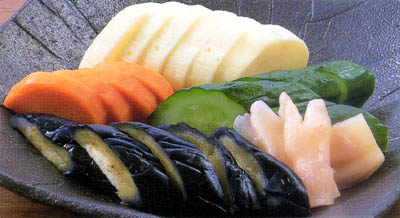Certain foods are strongly associated with drinking and are often known as otsumami. This is an honorific formed from the verb tsumamu, to pick something up by the fingertips (or chopsticks). Another expression for food specifically intended as an accompaniment to sake is sakana. Below are a few of the bits and pieces to be found at the elbow of drinkers in Japan - sakana every sake fan should try at least once.
 Chinmi Delicacies
At the top of the nibbler's hierarchy are the mysteriously named chinmi, written with characters meaning rare and taste, which pretty much conveys the idea. Every possible genre in Japan, from views and gardens to blue cheese and brewers' unions, has its official top-three ranking and these delicacies are no exception. The Three Great Delicacies, as established by the consensus of connoisseurs of the Edo period (1600-1868), are uni, karasumi, and konowata. The first and most common is sea urchin, a popular (although rather expensive) topping for sushi. Karasumi is mullet roe, salted and preserved by drying. It is usually served thinly sliced, and looks unspectacular, but its rich, subtle flavor is superb. It may be served as is, or lightly grilled, in which case the flavor takes on an aromatic, toasty, extra dimension. The third of the great trio is konowata, which is a crunchy variety of shiokara (see next entry) prepared from the entrails of the sea slug. Really.
Shiokara: Salt-Pickled Thingummies
Fish, shellfish, and various bits of their insides are the most common ingredients. The various salty bits and pieces come in a range of slime-creature colors and textures. The most common version is the pinkish one made from squid, called ika no shiokara. One of the foods traditionally loathed by Western visitors, these delicacies are certainly an acquired taste. I have been told that it is the amino acids, which accumulate in the curing process, that make them go so well with sake.
Tsukemono: Japanese Pickles
A wide variety of ingredients are pickled in a number of bases - salt, rice bran (nuka), soy sauce, vinegar, miso, koji, and the caked lees (kasu) left over when sake is pressed. The length of time varies from a few hours for ichiyazuke (one-night pickles), to a few months for vegetables done in salt and rice bran (takuan, made from the daikon radish, is the most popular), and several years for the famous Nara speciality of vegetables (primarily shirorui, a relative of the melon) pickled in sake lees. With such a range of flavors - from the light touch of ichiyazuke, to the vinegary tang of purple Kyoto shibazuke and the rich years' worth of taste in a slice of narazuke - it is easy to find the perfect companion for the lightest of ginjo or the funkiest of koshu.
|
This multicultural food-blog was created to share food and beverage recipes. The recipes will mostly focus on French, Chinese, Japanese, Dominican, Paraguayan and American cuisine. The purpose of this blog is to share recipes through daily postings of easy and fresh comfort-food. This blog will provide recipes of appetizers, entrées, desserts and cocktails in addition to reviews of restaurants and other food related events most often but not limited to the Boston area.
Thursday, December 6, 2012
Sake Drinkers' Food
Labels:
drinks,
Food,
japanese drinks,
sake
Subscribe to:
Post Comments (Atom)
No comments:
Post a Comment